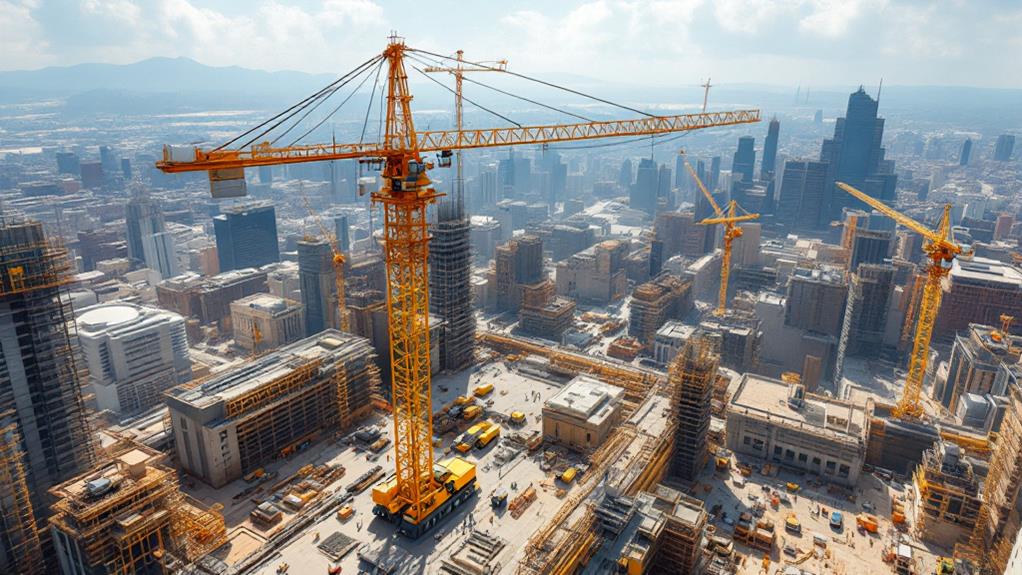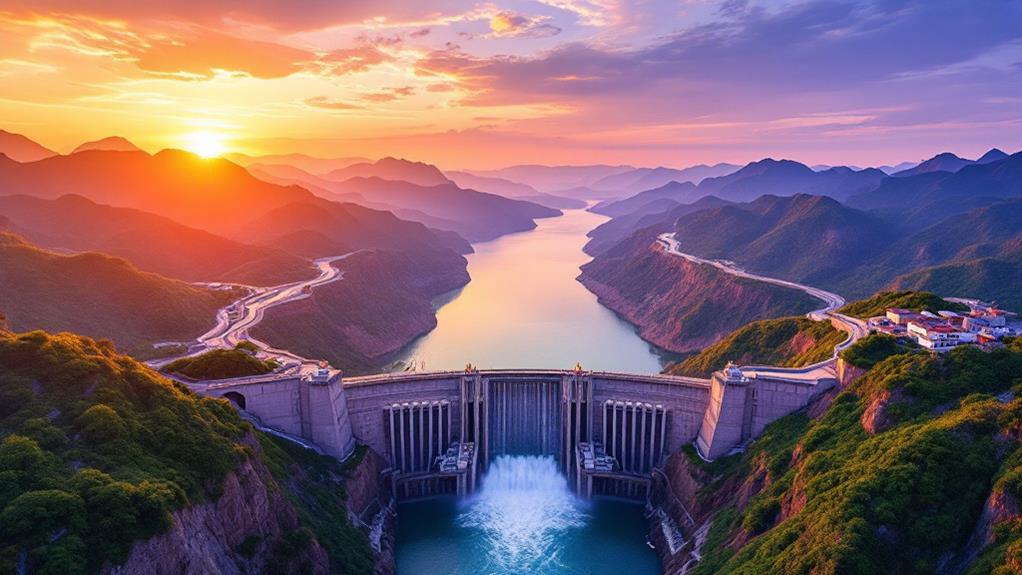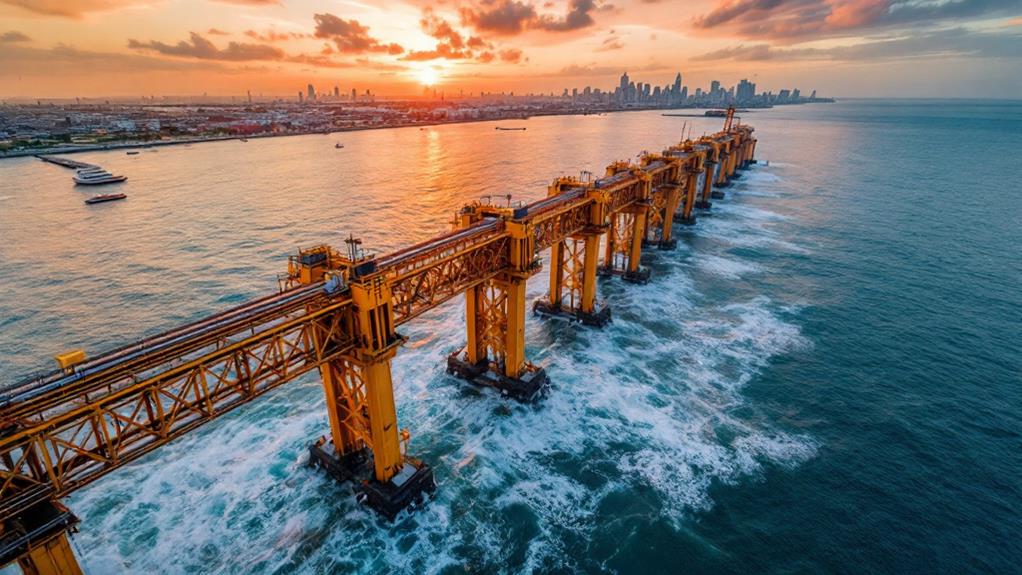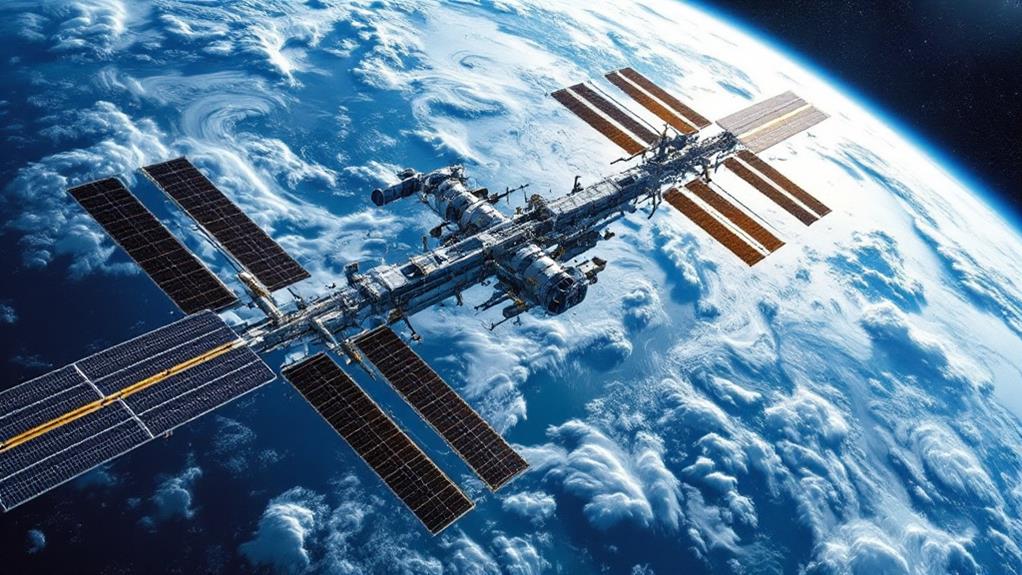Top 10 Largest Building Projects in the World: Engineering Marvels

You're about to uncover the world's top engineering marvels that showcase human ingenuity. The Burj Khalifa stands as the tallest skyscraper, while the Millau Viaduct soars as the highest cable-stayed bridge. The Panama Canal and Three Gorges Dam revolutionize waterways and power. The Channel Tunnel and Gotthard Base Tunnel redefine transportation infrastructure. Palm Islands mesmerize as the largest man-made islands. The Venice Tide Barrier combats rising sea levels. In space and science, the International Space Station and the Large Hadron Collider expand the frontiers of exploration. There's a wealth of detail about these groundbreaking projects awaiting your curiosity.
Burj Khalifa
Standing as a tribute to architectural prowess and ambition, the Burj Khalifa towers over Dubai at 828 meters, holding the title of the world's tallest building since 2010. Its impressive height isn't just for show; it's an engineering marvel that combines cutting-edge technology with sustainable design. The skyscraper's unique triple-lobed footprint, inspired by Islamic architecture, not only improves its aesthetic appeal but also optimizes its structural stability, allowing it to withstand high winds and seismic activities common in the region.
When you visit the Burj Khalifa, you're stepping into a world of luxury and innovation. From its opulent hotel and residences to state-of-the-art offices, every corner of this iconic building showcases Dubai's rapid development. The observation decks provide breathtaking views of the city, drawing millions of visitors each year who come to witness this symbol of human ingenuity.
Constructed with over 330,000 cubic meters of concrete, the Burj Khalifa stands as a demonstration of what can be achieved when ambition meets advanced engineering. It's not just the tallest building; it's a guiding light of sustainable design and a marvel of modern architecture that redefines the skyline of Dubai.
Panama Canal
Imagine a waterway that dramatically reshapes global maritime trade—welcome to the Panama Canal. This 51-mile-long artificial waterway connects the Atlantic and Pacific Oceans, transforming maritime transportation since 1914. It showcases one of the most impressive engineering marvels, reflecting the sheer human ingenuity involved. Let's examine the canal's key aspects:
- Construction Method: U.S. Chief Engineer John Stevens redesigned the canal to include locks and a man-made lake, enabling ships to traverse the elevation of roughly 3,000 feet between the oceans. Despite challenges, including a 10% worker mortality rate due to diseases and accidents, the project was completed on time and within budget.
- Locks System: The canal features a series of locks that ingeniously raise and lower ships, showcasing advanced engineering techniques. This system allows more than 14,000 ships annually to pass through, drastically reducing travel time and enhancing global trade.
- Economic Impact: By fostering economic growth in the region, the canal has become a crucial artery for global commerce, making it a cornerstone of maritime logistics.
- Human Ingenuity: The involvement of over 56,000 workers demonstrates a monumental achievement in construction methods and project management, etching the Panama Canal into history as an enduring symbol of human capability.
Three Gorges Dam

While the Panama Canal transformed maritime trade, the Three Gorges Dam exemplifies another monumental feat of engineering. Situated on the Yangtze River in Hubei, China, this incredible structure is the largest hydroelectric power station globally, boasting an impressive installed capacity of 22,500 megawatts. Its sheer size is astounding, stretching 7,661 feet (2,335 meters) and forming a reservoir about 600 kilometers (370 miles) long.
Construction began in 1994 and wrapped up in 2012, marking nearly two decades of unparalleled engineering efforts. The project wasn't without its challenges, as it required the relocation of over 1 million people due to the reservoir's flooding. Despite this, the dam plays a vital role in flood control, markedly reducing flood risks in downstream areas. It's also fundamental for irrigation and improving navigation along the Yangtze River, offering a lifeline to many communities.
However, the Three Gorges Dam has sparked criticism due to its ecological impact. Concerns include landslides, pollution, and the submergence of historical sites. These issues highlight the complex balance between human advancement and environmental preservation, a theme that's increasingly pertinent today.
Channel Tunnel
Connecting England and France beneath the English Channel, the Channel Tunnel stands as the longest underwater rail tunnel globally, measuring 31 miles in total. This engineering and architectural marvel, also known as the Chunnel, features a 23-mile underwater section that showcases one of the largest man-made structures of its kind. You might be fascinated to know that the Channel Tunnel was opened in 1994 and remains a showcase of international collaboration and precise construction.
Here's why the Channel Tunnel is an engineering feat worth exploring:
- Tunneling Machines: The construction involved massive 1,100-ton machines that bored through the earth, crafting three separate tubes—two for trains and one for emergencies.
- Depth: The average depth below the seabed is about 150 feet, highlighting the engineering prowess required to maintain safety and stability.
- Passenger Convenience: Over 7 million Eurostar passengers use the tunnel annually, cutting travel time between London and Paris to under two hours.
- Project Success: Despite initial skepticism, the project was completed on time and within budget, marking a success in international engineering collaboration.
The Channel Tunnel not only connects two nations but also exemplifies what's possible when vision meets engineering expertise.
Palm Islands

The Palm Islands in Dubai, UAE, represent a remarkable feat of human ingenuity and ambition, reshaping the coastline with the world's largest man-made islands. These engineering marvels were created through extensive sand dredging and land reclamation techniques. Construction began in 2001, involving about 94 million cubic meters of sand and 7 million tons of rock to build the breakwater. Among the trio of islands, Palm Jumeirah stands out with its iconic palm tree shape, completed in 2006. This island alone has transformed Dubai's skyline and notably enhanced its tourism industry.
When you visit Palm Jumeirah, you're stepping into a world of opulence. It hosts over 18,000 residents and boasts luxury hotels, residences, and leisure facilities. One landmark you can't miss is Atlantis, The Palm—a resort featuring a thrilling water park and a mesmerizing aquarium. These attractions draw millions of tourists each year, making Palm Jumeirah a lively hub of activity.
The creation of the Palm Islands showcases Dubai's ambition to push the boundaries of what's possible. It's not just about land reclamation; it's about redefining luxury living and tourism on a grand scale.
Millau Viaduct
After exploring the grandeur of Dubai's Palm Islands, let's shift our gaze to the engineering masterpiece that is the Millau Viaduct. Positioned in the picturesque landscape of Millau, France, this marvel stands as the tallest cable-stayed road bridge globally, towering at 1,125 feet (343 meters) above the Tarn River Valley. Surpassing the height of the Eiffel Tower, it's an astonishing sight and a symbol of modern engineering wonders. Designed by French engineer Michel Virlogeux and architect Norman Foster, its impressive construction was completed in December 2004.
Here's what makes the Millau Viaduct exceptional:
- Height and Design: The bridge incorporates 7 pylons, with the tallest reaching 246 meters (807 feet), elegantly supporting its span.
- Length and Functionality: Stretching 7,868 feet (2,460 meters), it facilitates efficient travel between Paris and Barcelona, greatly reducing travel time.
- Resource Utilization: Its construction utilized 127,000 cubic meters of concrete and 19,000 tons of steel, showcasing careful planning and resource management.
- Impact on Traffic: By alleviating traffic congestion, it improves road safety and serves as an essential infrastructure project for the region.
The Millau Viaduct isn't just a bridge; it's a symbol of innovation and progress, seamlessly blending utility with breathtaking design.
Venice Tide Barrier

Initiated in 2003, the Venice Tide Barrier Project stands as a monumental effort to safeguard the historic city of Venice from the relentless threat of rising sea levels and flooding. You might marvel at the sheer scale and ambition of this engineering feat, which includes 78 rotating gates. Each gate towers approximately 20 feet high and stretches 60 feet wide, ready to rise and form a protective shield against high tides and storm surges that threaten the Venetian Lagoon.
With an estimated cost of about $6 billion, this project took nearly 20 years to complete, highlighting the significant engineering and logistical hurdles it had to overcome. As you navigate Venice's charming canals and admire its unique architecture, keep in mind that this barrier is essential for preserving the city's cultural heritage. Without it, the beauty and history of Venice could be lost to the encroaching waters accelerated by climate change.
However, even with its completion, the Venice Tide Barrier Project hasn't been without its share of controversies and delays, sparking debates over its long-term effectiveness and environmental impact. Still, it remains a reflection of human ingenuity and the lengths we go to protect our history.
Gotthard Base Tunnel
While the Venice Tide Barrier focuses on protecting a historic city from the forces of nature, the Gotthard Base Tunnel stands as a demonstration of human engineering triumph over geographical challenges. Stretching 35.5 miles (57.1 kilometers) beneath the Swiss Alps, it's the longest railway and deepest traffic tunnel globally. Completed in 2016, this monumental feat of construction slashed travel times across the Alps, transforming Switzerland's transportation infrastructure.
When you investigate the Gotthard Base Tunnel, consider these key aspects:
- Construction Duration: It took nearly two decades to complete, involving around 2,500 workers who crafted approximately 28,000 construction drawings.
- Design and Structure: The tunnel comprises two parallel tubes, each with a diameter of 9.5 meters (31 feet), allowing trains to zoom through at speeds up to 250 km/h (155 mph).
- Cost: This ambitious project required a staggering $12 billion investment, underscoring its significance in enhancing both passenger and freight transport efficiency.
- Impact: By reducing travel time, the Gotthard Base Tunnel has transformed logistics and connectivity in Europe, making it a cornerstone of modern transportation infrastructure.
Witnessing this engineering marvel, you'll appreciate how it represents a leap in overcoming natural barriers to connectivity.
International Space Station

Amidst the vast expanse of space, the International Space Station (ISS) stands as the largest human-made structure orbiting Earth. Spanning roughly 357 feet in length and 240 feet in width, this colossal structure weighs around 420,000 kilograms (925,000 pounds). Since its launch in 1998 and continuous habitation from November 2000, the ISS has been a guiding light of scientific research and space exploration.
You'd be amazed at how this microgravity laboratory orbits Earth at an altitude of about 420 kilometers (261 miles), traveling at a staggering speed of 28,000 kilometers per hour (17,500 miles per hour). It's not just a marvel of engineering, but also a proof of international cooperation. The ISS is a collaborative effort among five major space agencies: NASA, Roscosmos, ESA, JAXA, and CSA. This global partnership has enabled over 240 astronauts from 19 different countries to live and work on the station, pushing the boundaries of scientific research.
Onboard, scientists conduct experiments across different fields, enhancing our understanding of biology, physics, and the universe. The ISS exemplifies what humanity can achieve through collaboration, curiosity, and a shared vision for space exploration.
Large Hadron Collider
In the domain of groundbreaking scientific endeavors, the Large Hadron Collider (LHC) stands as a monumental achievement on Earth, just as the International Space Station is a marvel in the cosmos. Located at CERN near Geneva, Switzerland, the LHC is the world's largest and highest-energy particle accelerator, stretching an impressive 17 miles in circumference. This feat of modern engineering was completed in 2008, designed to push the boundaries of our understanding of particle physics.
Here's what makes the LHC extraordinary:
- Innovative Engineering: The LHC operates at energies up to 13 TeV, utilizing superconducting magnets cooled to a frigid -271.3°C to produce billions of particle collisions per second.
- World's Largest Concrete Structure: The collider's massive underground ring is supported by an extensive concrete structure, ensuring stability and precision in experiments.
- Four Major Detectors: ATLAS, CMS, LHCb, and ALICE each play essential roles in studying different aspects of particle collisions.
- Significant Findings: Among its many achievements, the LHC confirmed the existence of the Higgs boson in 2012, helping to answer fundamental questions about the origins of mass.
The LHC truly embodies the spirit of pushing scientific boundaries with its remarkable contributions to physics.



